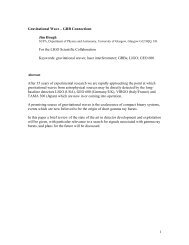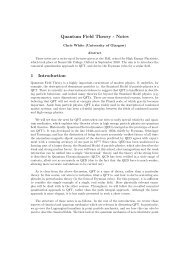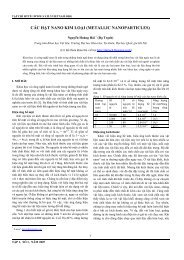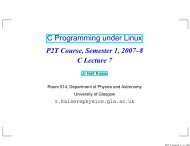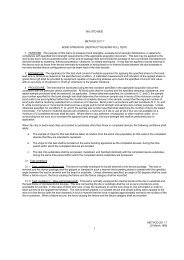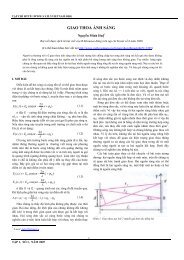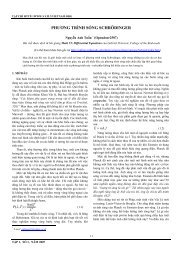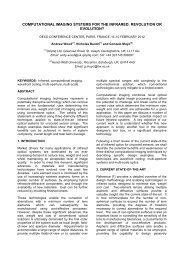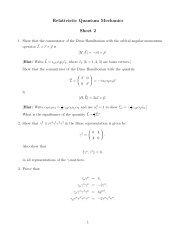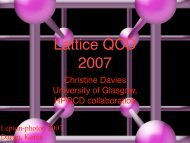In vivo Real-time Tracking of Single Quantum Dots Conjugated with ...
In vivo Real-time Tracking of Single Quantum Dots Conjugated with ...
In vivo Real-time Tracking of Single Quantum Dots Conjugated with ...
Create successful ePaper yourself
Turn your PDF publications into a flip-book with our unique Google optimized e-Paper software.
Research Article<strong>In</strong> <strong>vivo</strong> <strong>Real</strong>-<strong>time</strong> <strong>Tracking</strong> <strong>of</strong> <strong>Single</strong> <strong>Quantum</strong> <strong>Dots</strong> <strong>Conjugated</strong><strong>with</strong> Monoclonal Anti-HER2 Antibody in Tumors <strong>of</strong> MiceHiroshi Tada, 1 Hideo Higuchi, 2 Tomonobu M. Wanatabe, 2 and Noriaki Ohuchi 11Division <strong>of</strong> Surgical Oncology, Graduate School <strong>of</strong> Medicine and 2 Biomedical Engineering Research, Organization,Tohoku University, Sendai, JapanAbstractStudies <strong>with</strong> tracking <strong>of</strong> single nanoparticles are providingnew insights into the interactions and processes involved inthe transport <strong>of</strong> drug carriers in living mice. Here, we reportthe tracking <strong>of</strong> a single particle quantum dot (Qdot)conjugated <strong>with</strong> tumor-targeting antibodyin tumors <strong>of</strong> livingmice using a dorsal skinfold chamber and a high-speedconfocal microscope <strong>with</strong> a high-sensitivitycamera. Qdotlabeled <strong>with</strong> the monoclonal anti-HER2 antibodywas injectedinto mice <strong>with</strong> HER2-overexpressing breast cancer to analyzethe molecular processes <strong>of</strong> its mechanistic deliveryto thetumor. Movement <strong>of</strong> single complexes <strong>of</strong> the Qdot-antibodycould be clearlyobserved at 30 frames/s inside the tumorthrough a dorsal skinfold chamber. We successfullyidentifiedsix processes <strong>of</strong> delivery: initially in the circulation <strong>with</strong>in ablood vessel, during extravasation, in the extracelullar region,binding to HER2 on the cell membrane, moving from the cellmembrane to the perinuclear region, and in the perinuclearregion. The six processes were quantitativelyanalyzed tounderstand the rate-limiting constraints on Qdot-antibodydelivery. The movement <strong>of</strong> the complexes at each stage was‘‘stop-and-go.’’ The image analysis <strong>of</strong> the delivery processes <strong>of</strong>single particles in <strong>vivo</strong> provides valuable information onantibody-conjugated therapeutic nanoparticles, which willbe useful in increasing therapeutic efficacy. [Cancer Res2007;67(3):1138–44]<strong>In</strong>troductionRecent anticancer therapeutics based on active tumor targetingby conjugating tumor-specific antibodies has become <strong>of</strong> greatinterest in oncology, pharmacology, and nanomedicine. Thisapproach will allow to increase therapeutic efficacy and todecrease systemic toxicity (1–3). Quantitative investigation <strong>of</strong> thedynamics <strong>of</strong> such delivery in <strong>vivo</strong> is crucial in enabling thedevelopment <strong>of</strong> more effective drug delivery systems. One <strong>of</strong>the best ways to do this is to apply a new technology in biophysicswherein the positions <strong>of</strong> proteins are detected quantitatively at thesingle molecule or particle level <strong>with</strong> nanometer precision (4).However, the specific processes <strong>of</strong> its delivery in <strong>vivo</strong> postinjectionare not known at the single particle level. Conventional modalities<strong>of</strong> in <strong>vivo</strong> imaging such as computed tomography, magneticNote: Supplementary data for this article are available at Cancer Research Online(http://cancerres.aacrjournals.org/).Requests for reprints: Hideo Higuchi, Biomedical Engineering ResearchOrganization, Tohoku University, Engineering research Lab complex, 6-6-11 Aramaki,Aoba-ku, Sendai, Miyagi 980-8578, Japan. Phone: 81-22-795-4735; Fax: 81-22-795-5753;E-mail: higuchi@tubero.tohoku.ac.jp.I2007 American Association for Cancer Research.doi:10.1158/0008-5472.CAN-06-1185resonance imaging, positron emission tomography, and organicfluorescence or luminescence imaging have insufficient resolutionto analyze the pharmacokinetics <strong>of</strong> drugs at the single particle levelin <strong>vivo</strong> (5).To address the issue, real-<strong>time</strong> single particle tracking usingquantum dots (Qdots) has been applied to the study <strong>of</strong> drugdelivery. Qdots, fluorescence nanocrystals, were thought to be as asuitable marker because <strong>of</strong> their intense brightness and stability, incontrast to organic dyes and green fluorescent protein (6–8). <strong>In</strong>cultured cells, single particle tracking has yielded invaluableinformation on the function <strong>of</strong> purified proteins (9–11). Recentworkshows that the antibody-conjugated Qdots have allowed real<strong>time</strong>tracking <strong>of</strong> single receptor molecules on the surface <strong>of</strong> livecells (12). However, no real-<strong>time</strong> single particle tracking in liveanimals has been reported, and it is uncertain that single particles<strong>of</strong> Qdots could be observed and tracked in live animals. Theanalysis <strong>of</strong> single molecules and particles in living animals iscrucial to the understanding <strong>of</strong> the molecular mechanism <strong>of</strong>proteins in <strong>vivo</strong>.This study was designed to analyze the movement <strong>of</strong> singlefunctional Qdots in tumors <strong>of</strong> mice from a capillary vessel tocancer cells. To observe single Qdot particles in tumor tissue, weused a dorsal skinfold chamber model (13) and a high-resolutionintravital imaging system. The imaging system, which consists <strong>of</strong> aconfocal scanner unit <strong>with</strong> a Nipkow type disk and an electronmultiplying charge coupled device (EMCCD) camera (14), facilitatesthe high-resolution in <strong>vivo</strong> single particle tracking at a videorate <strong>with</strong> a high spatial resolution <strong>of</strong> 30 nm. <strong>In</strong> addition,quantitative and qualitative information such as velocity, directionality,and transport mode was obtained using <strong>time</strong>-resolvedtrajectories <strong>of</strong> particles. As a result, we successfully identified theprocesses <strong>of</strong> delivery; these were quantitatively analyzed tounderstand the rate-limiting constraints on single Qdot-antibodydelivery in <strong>vivo</strong>.Materials and MethodsQdot-antibodyconjugation. Qdot was conjugated to trastuzumab(Herceptin, Chugai Pharmaceuticals Co., Ltd., Tokyo, Japan) <strong>with</strong> a Qdot 800Antibody Conjugation Kit (<strong>Quantum</strong> Dot Corp., Hayward, CA) coated <strong>with</strong>polyethylene glycol (PEG) amine (MW 2,000) according to the manufacturer’sinstruction. Briefly, Qdots are activated <strong>with</strong> the heterobifunctionalcross-linker 4-(maleimidomethyl)-1-cyclohexanecarboxylic acid N-hydroxysuccinimideester (SMCC), yielding a maleimide-nanocrystal surface.Excess SMCC is removed by size exclusion chromatography. Antibody isthen reduced and fragmented by DTT to expose free sulfhydryls, and excessDTT is removed by size exclusion chromatography. Then, activated Qdotsare covalently coupled <strong>with</strong> reduced antibody and reaction is quenched<strong>with</strong> h-mercaptoethanol. The molar ratio <strong>of</strong> trastuzumab fragments to theQdots at mixing is f3:1. Conjugates are concentrated by ultrafiltration andpurified by size exclusion chromatography. This active ester maleimide–mediated amine and sulfhydryl coupling (by SMCC) is a popular crosslinkingreaction for various antibody conjugations. After this reduction,Cancer Res 2007; 67: (3). February 1, 2007 1138 www.aacrjournals.org
<strong>Real</strong>-<strong>time</strong> <strong>Tracking</strong> <strong>of</strong> <strong>Single</strong> Qdots in Mouse TumorsFigure 1. Immunocytochemical studies <strong>of</strong>QT-complex binding activity in culturedbreast cancer cells. A, KPL-4 cells, whichare HER2 positive, as revealed by thepresence <strong>of</strong> the QT complex on the cellsurface. B, negative staining was detectedin KPL-4 cells exposed to QD-PEG inthe absence <strong>of</strong> anti-HER2 antibody.C, negative staining was detected inMDA-MB-231 cells, which are HER2negative. D, competition study <strong>of</strong> QTcomplex and trastuzumab. After addition <strong>of</strong>100 nmol/L trastuzumab to KPL-4 cells,QT-complex fluorescence was absent.QT-complex fluorescence was detectedon the cell surface <strong>of</strong> KPL-4 but notMDA-MB-231, confirming HER2 as a cellsurface–specific marker for some breastcancer cell lines.it has been found to have little or no effect on their binding ability. QTcomplex [Qdot (Q)-trastuzumab (T) complex] was fractionated by agarosegel electrophoresis into three major bands. Approximately 60% <strong>of</strong> the QTcomplex was conjugated <strong>with</strong> three antibody fragments, f30% <strong>with</strong> tw<strong>of</strong>ragments, and f10% <strong>with</strong> a single fragment (data not shown).The final concentration <strong>of</strong> QT complexes was determined by measuringthe conjugate absorbance at 550 nm and using an extinction coefficient <strong>of</strong>1,700,000 M 1 cm 1 at 550 nm.Cell line and mouse model. The human breast cancer cell line KPL-4,which overexpresses HER2 and is sensitive to trastuzumab (15, 16), waskindly provided by Dr. J. Kurebayashi (Kawasaki Medical school, Kurashiki,Japan). KPL-4 cells were cultured in DMEM supplemented <strong>with</strong> 5% fetalbovine serum (FBS). MDA-MB-231 cells were maintained in RPMI <strong>with</strong> 10%FBS. Conventional immunohistochemical procedures were used todetermine the binding <strong>of</strong> QT-complex conjugate to KPL-4 cells, using bothQD-PEG (no antibody) and MDA-MB-231 as negative controls. <strong>In</strong> thesestudies, QT-complex or QD-PEG bioconjugates (100 nmol/L) wereincubated <strong>with</strong> the cells for 30 min at 37jC, washed, and photographed.For competition study <strong>of</strong> QT complex and trastuzumab, KPL-4 waspretreated <strong>with</strong> trastuzumab (100 nmol/L) for 30 min before exposure to100 nmol/L QT complex.A suspension <strong>of</strong> KPL-4 cells (0.8 10 7 per mouse) was transplanted s.c.to the dorsal skin <strong>of</strong> female BALB/c nu/nu mice at 6 to 10 weeks <strong>of</strong> age(Charles River Japan, Yokohama, Japan). Several weeks after tumorinoculation, mice bearing a tumor volume <strong>of</strong> 100 to 200 mm 3 wereselected. All <strong>of</strong> the mice were maintained in our pathogen-free institutionalfacilities. All operations on animals were in accordance <strong>with</strong> theinstitutional animal use and care regulations.QT complexes were injected into the tail vein <strong>of</strong> mice at a concentration<strong>of</strong> 2 Amol/L and a volume <strong>of</strong> 100 AL. The mice were placed under anesthesiaby the i.p. injection <strong>of</strong> a ketamine and xylazine mixture at dosages <strong>of</strong> 95 and5 mg/kg, respectively. The temperature <strong>of</strong> mice was maintained at 37jC<strong>with</strong> a thermoplate and objective lens heater.The dorsal skinfold chamber, previously described (13) and modified forthis study, was used to fix the exposed mouse tumor on the stage <strong>of</strong> themicroscope. Two sterilized polyvinyl chloride plates (0.5-mm thickness)containing a window were mounted to fix the extended double layer <strong>of</strong>dorsal skin including the tumor site. Skin between chambers was suturedtogether <strong>with</strong> 6-0 nylon around the window so the tumor could be locatedin the center <strong>of</strong> the window and fixed <strong>with</strong>out influence from the beating <strong>of</strong>the heart and/or breathing. The tumor was exposed by oval incision <strong>of</strong>f10-mm diameter, and the s.c. connective tissue was removed. The tumorwas then placed surface down in neutral saline, mounted on coverslip, andviewed under an inverted microscope. The mouse was fixed to a metal plateon the stage designed to stabilize the chamber. Tumors can be visualizeddirectly by means <strong>of</strong> this setup.www.aacrjournals.org 1139 Cancer Res 2007; 67: (3). February 1, 2007
Cancer ResearchAfter imaging, the mice were sacrificed by CO 2 overdose. The tumorswere removed and divided for histologic Qdot uptake study andimmunohistochemical analysis. For the histologic Qdot uptake study,tumors were frozen and cryosectioned (6-Am thickness), fixed <strong>with</strong> acetoneat 0jC, and examined <strong>with</strong> an imaging system. For immunohistologicexamination, tumors were fixed in 10% neutral-buffered formalin overnightand then transferred to ethanol before processing and paraffin embedding.Immunohistochemical analysis was done on paraffin sections <strong>of</strong> 6-mmthickness using the HercepTest (DakoCytomation, Carpinteria, CA).<strong>In</strong> <strong>vivo</strong> imaging and tracking. Optics and image analysis: The opticssystem for three-dimensional observation consisted primarily <strong>of</strong> anepifluorescent microscope (IX71, Olympus, Tokyo, Japan) <strong>with</strong> modifications(17, 18), a Nipkow lens type confocal unit (CSU10, Yokokawa, Japan),and an electron multiplier type CCD camera (iXon 887, Andor, Tokyo,Japan). The confocal unit adopts multibeam scanning using about athousand beams that are simultaneously emitted through a pin-hole diskt<strong>of</strong>acilitate high-speed scanning. The EMCCD has an advantage that <strong>of</strong>fersunsurpassed sensitivity performance and has been shown to yield markedlyimproved S/N (signal/noise) ratio (14). The object lens (60, numericalaperture 1.45) was moved by a piezo actuator <strong>with</strong> a feedbackloop(Nanocontrol) for stabilizing the position <strong>of</strong> the focus. A computercontrolled the piezo actuator in synchronization <strong>with</strong> the imageacquisitions that the object lens remained <strong>with</strong>in the exposure <strong>time</strong> <strong>of</strong>the CCD camera. An area <strong>of</strong> f30 30 Am 2 was illuminated by a green laser(532 nm, CrystaLaser, Reno, NV). This system captures images <strong>of</strong> singleQdot at a video rate <strong>of</strong> 33 ms/frame. Three-dimensional confocal intravitalimages <strong>of</strong> single QT complex were taken by moving an objective lens(Fig. 2A). Three-dimensional images <strong>of</strong> the tumor were taken byreconstructing 10 to 20 confocal images from the surface <strong>of</strong> the mice to adepth <strong>of</strong> 150 Am inside the tumor through the DSFC.The xy position <strong>of</strong> the fluorescent spot was calculated by fitting to a twodimensionalGaussian curve. The single molecule could be identified by thefluorescence intensity. <strong>In</strong> addition, quantitative and qualitative informationsuch as velocity, directionality, and transport mode was obtained using<strong>time</strong>-resolved trajectories <strong>of</strong> particles. The resolution <strong>of</strong> the position wasdetermined from the position <strong>of</strong> immobile QT complexes in a chemicallyfixed tumor cell. The resolution <strong>of</strong> the x and y directions <strong>of</strong> images taken atan exposure <strong>time</strong> <strong>of</strong> 33 ms was 30 nm, taking into consideration the SD.(Supplementary Fig. S1A and B). <strong>Single</strong> Qdots in the mice tumorwere observed using a high-resolution intravital imaging systemthrough the dorsal skinfold chamber (Fig. 2A; ref. 13). Fluorescencemicroangiography was done after injection <strong>of</strong> the QTcomplexes into the tail vein. After injection, blood sample frommice was examined by fluorescence observation on whether QTcomplex had made the aggregation in the mice. QT complexexisted as a single particle <strong>with</strong>out further aggregation (data notshown). The membranes <strong>of</strong> the KPL-4 tumor cells were clearlystained <strong>with</strong> single QT complexes at 6 h after the injection. At24 h after the injection, the QT complexes had been internalizedinto the tumor cells (Fig. 2B and C). After imaging <strong>of</strong> the tumorsin the living mice, histologic examination <strong>of</strong> the chemically fixedtumors was done to confirm that QT complexes in the living miceexhibit activity in KPL-4 cells. QT complexes observed under athree-dimensional microscope were located at the cell membraneand near the nuclear membrane (Supplementary Fig. S2A and B).An adjacent slice <strong>of</strong> the observed area was further stainedResults and Discussions<strong>In</strong> vitro study. Qdots were conjugated to trastuzumab using theQdot-antibody conjugation kit (QT complex). Immunocytochemicaldata confirmed strong and specific binding <strong>of</strong> the QT complex to aHER2-overexpressing human breast cancer cell line (Fig. 1A). QD-PEG <strong>with</strong>out antibody showed almost no binding to KPL-4 cells(Fig. 1B). MDA-MB-231, a HER2 negative human breast cancer cellline, showed the absence <strong>of</strong> Qdot binding (Fig. 1C). KPL-4 cellspretreated by excess trastuzumab also showed the absence <strong>of</strong> Qdotbinding (Fig. 1D). These results indicate that QT complexesselectively bind to the HER2 protein. Furthermore, QT complexwas compared <strong>with</strong> trastuzumab labeled <strong>with</strong> rhodamine, which isrecognized as similar to native trastuzumab. Both QT complex andrhodamine-trastuzumab bound to the KPL-4 cell at concentrations<strong>of</strong> 1 nmol/L but hardly at 0.1 nmol/L, indicating the bindingproperties <strong>of</strong> QT complex are similar to those <strong>of</strong> native antibody(data not shown).Three-dimensional imaging <strong>of</strong> single Qdot-trastuzumab inmice. It is reported that the accumulation <strong>of</strong> trastuzumab at theHER2-overexpressing tumor site in mice model is the basis forradioimmunoscintigraphic scanning and targeted therapy forhuman HER2-overexpressing breast cancer (19–21). Here tumorbearingmouse models were prepared <strong>with</strong> KPL-4 s.c. implantation.The QT complex accumulated in the tumor specificallybecause only the tumor area generated fluorescence <strong>of</strong> QdotsFigure 2. Experimental diagram and three-dimensional intravital cancerimaging. Mice prepared for dorsal skinfold chamber were fixed on themicroscopic stage. QT complexes were injected into the tail vein <strong>of</strong> nude BALB/cmice bearing KPL-4 breast cancer xenograft tumor. A, three-dimensionalmicroscopic system consisting <strong>of</strong> a confocal unit, an EMCCD, and a computer tocontrol the piezo stage. B, three-dimensional image <strong>of</strong> the tumor was obtainedby the QT complexes binding to tumor cell membrane (stereoscopic image: leftand right field). C, traced outlines <strong>of</strong> the cells shown in (B).Cancer Res 2007; 67: (3). February 1, 2007 1140 www.aacrjournals.org
<strong>Real</strong>-<strong>time</strong> <strong>Tracking</strong> <strong>of</strong> <strong>Single</strong> Qdots in Mouse Tumorsimmunohistochemically <strong>with</strong> the anti-HER2 antibody A0485. Thecell membrane stained locally in the adjacent slice (SupplementaryFig. S2C), confirming that QT complexes were present on themembrane <strong>of</strong> tumor cells.Extravasation <strong>of</strong> single QT complexes in tumors <strong>of</strong> mice <strong>with</strong>two-dimensional imaging. After the injection, three-dimensionalimages <strong>of</strong> the tumor were taken to allow observation on the tumorvessel <strong>of</strong> single QT complexes. The position <strong>of</strong> the objective wasfixed and 300 to 3,000 sequential confocal two-dimensional images(total, 10–100 s) were taken at this fixed position. Within 30 s afterthe injection, the current <strong>of</strong> the QT complex in a vessel wasobserved. When the vessel and cells were clearly observable, the thecurrent <strong>of</strong> single QT complex in the tumor vessel was thenanalyzed. The fluorescent image <strong>of</strong> the circulating QT complex wasnot a circle but an ellipse and some<strong>time</strong>s a line at the video ratebecause QT complex at <strong>time</strong>s moved >1 Am in single frame. Thespeed <strong>of</strong> the movement <strong>of</strong> the single particles was calculated fromthe positional changes <strong>of</strong> the centroid <strong>of</strong> the QT complex images(Fig. 3A). The average speed <strong>of</strong> each complex ranged from 100 to600 Am/s, in agreement <strong>with</strong> a previous report by another method(22). As shown in Fig. 3A, each particle exhibits slow and fastmovement in the bloodstream. Such fast and slow movementcharacteristics could be induced by the pulse and nonuniformcurrent <strong>with</strong>in a vessel such as the Hagen-Poiseuille current. Theslow speed <strong>of</strong> the complexes inside a tumor vessel would beimportant to locate pores between the vessel cells and then thecomplexes diffuse out from these pores.Focusing on the vessel walls, a movement was observed <strong>of</strong> thecomplex extravasated from the intravascular space (Fig. 3B). Theedge <strong>of</strong> the vascular inner surface was not clear on a single frameimage. Therefore, all the images obtained were averaged toprecisely determine the position <strong>of</strong> the edge (Fig. 3B, i–iii). Thecomplexes were positioned first on the vascular surface and thenextravasated. This is the first example <strong>of</strong> video rate observation <strong>of</strong>extravasation <strong>of</strong> very small particles, such as Qdots, in a mousemodel. The moving speed <strong>of</strong> the complexes was very low, 1 to 4Am/s, at the pore <strong>of</strong> the vascular cells, compared <strong>with</strong> the speed inthe current. The QT complexes either interacted <strong>with</strong> the vascularcells or became trapped in the extracellular matrix.Diffusion <strong>of</strong> single QT complexes in extracellular andintercellular regions. Two hours after the injection, manycomplexes had migrated into the tumor interstitial area close tothe tumor vessels. Most <strong>of</strong> the movement <strong>of</strong> the complexes wasrandom in orientation and speed, indicating that complexes diffuseby the Brownian motion exerted by thermal energy. The averagediffusion coefficient <strong>of</strong> the complexes was 0.0014 Am 2 /s, muchsmaller than that at free diffusion in solution (f10 Am 2 /s). Manycomplexes also moved randomly <strong>with</strong>in a restricted small area <strong>of</strong>f1-Am diameter and then hopped by f1 Am (Fig.4A). Theseresults indicate that movement is restricted by a cage formed bythe extracellular matrix and, at <strong>time</strong>s, complexes escape from thiscage.Binding <strong>of</strong> QT complexes to cell membrane and vesicletransport. Six hours after the injection, QT complexes had boundto the KPL-4 cell membrane on which the HER2 protein islocated. We successfully captured specific images <strong>of</strong> the QTcomplexes bound to the cell membrane (Fig. 4B). Movements <strong>of</strong>single QT complex are identified in single frames. To identify thepositions <strong>of</strong> the tumor vessels and cells in living mice <strong>with</strong>outfurther fluorescence staining, images were averaged (SupplementaryFig. S3A). As viewed from the outside <strong>of</strong> the delineated cells,the QT complexes moved toward the cell membrane at a speed <strong>of</strong>200 to 400 nm/s (Fig. 4C), remained on the membrane for a fewseconds, and then moved randomly along the membrane. QTcomplexes moved between the cells, bound to HER2, and thenmoved in association <strong>with</strong> HER2 on the membrane.Many QT complexes bound to the cell membrane exhibitedBrownian motion <strong>with</strong>in a restricted region <strong>of</strong> f500-nm diameter.The region is significantly larger than the area <strong>of</strong> f30 nm, whichwas drawn by position noise <strong>of</strong> the complexes fixed on a coverslip,indicating the movement is due to the anchor <strong>of</strong> the HER2 to aflexible component <strong>of</strong> the cytoskeleton such as an actin filament(23). The QT complexes restricted to the small area initiated linearmovement in one direction along the cell membrane <strong>with</strong> a speed<strong>of</strong> 400 to 600 nm/s and traveled for several micrometers (Fig. 5Aand B; Supplementary Fig. S3B).We also succeeded in pursuing the transport <strong>of</strong> QT complexesfrom the peripheral region <strong>of</strong> the cell to the perinuclear regionFigure 3. The movement <strong>of</strong> QTcomplexes from tumor vessels to theinterstitial space. A, flow<strong>of</strong> QT complexesin the tumor vessel. The speed wascalculated by the moving distance per33 ms. The maximum speed was f600Am/s. B, extravasation <strong>of</strong> QT complexesfrom the vascular space <strong>of</strong> the tumor.Dotted line, trajectory <strong>of</strong> the extravasation.i, an initial single frame tracing thetrajectory <strong>of</strong> a single QT complex shown asa dotted line at video rate. ii, sequentialframes were averaged to define the edge <strong>of</strong>vessel. iii, tracing <strong>of</strong> the outlines <strong>of</strong> tumorvessels. Overlapping initial single imageand (iii), the tracing image gives the finalimages. B, inset, magnified image <strong>of</strong> thetrajectory <strong>of</strong> extravasating QT complex.www.aacrjournals.org 1141 Cancer Res 2007; 67: (3). February 1, 2007
Cancer ResearchFigure 4. <strong>Tracking</strong> the movement <strong>of</strong> QTcomplexes from the interstitial space to thecell membrane. A, trajectory <strong>of</strong> the QTcomplexes in the interstitial space near thetumor vessels and magnified trajectory.The color <strong>of</strong> the trajectory codes the <strong>time</strong>axis from black to pink, yellow, and lightblue. B, trajectory <strong>of</strong> the binding to thecell membrane and magnified trajectory.C, <strong>time</strong> trajectory <strong>of</strong> the velocity <strong>of</strong> (B).The color <strong>of</strong> the trajectory <strong>of</strong> both (B) and(C) codes the <strong>time</strong> axis from blue to redand green. All <strong>time</strong> trajectories <strong>of</strong> thevelocity are calculated by the least squaresmethod (2 s).(Fig. 5C; Supplementary Fig. S3C). The QT complex in a given cellmoved almost straight toward the cell membrane <strong>with</strong> a velocity <strong>of</strong>100 to 300 nm/s, changed direction to parallel to the cellmembrane, and moved toward the cell nucleus at a velocity <strong>of</strong>f600 nm/s (Fig. 5D). Finally, the directional movement <strong>of</strong> the QTcomplexes ceased and Brownian motion commenced <strong>with</strong>in asmall area, f1 Am in a diameter, near the nucleus (Fig. 5C and D,black line). The first two movements <strong>of</strong> straight toward and alongthe cell membrane would most likely be produced by the transport<strong>of</strong> an acto-myosin system binding to vesicle containing QTcomplexes (24, 25). Because the actin filaments in cultured cellsare highly concentrated in the peripheral region <strong>of</strong> cells, movementtoward the nucleus would most likely be on a microtubuletransported by dynein (26) as there are almost no actin filamentsnear nucleus, but rather, a high concentration <strong>of</strong> microtubules.Summary<strong>of</strong> the deliveryprocesses. We have succeeded incapturing the specific delivery <strong>of</strong> single QT complexes in tumorvessels to the perinuclear region <strong>of</strong> tumor cells in live mice after QTcomplexes had been injected into the tail vein <strong>of</strong> mice. Six stageswere detected (Fig. 6): (a) vessel circulation, (b) extravasation, (c)movement into the extracellular region, (d) binding to HER2 on thecell membrane, (e) movement from the cell membrane to theperinuclear region after endocytosis, and (f ) in the perinuclearregion. The translational speed <strong>of</strong> QT complexes in each processwas highly variable, even in the vessel circulation. The movement<strong>of</strong> the complexes in each process was also found to be ‘‘stop-andgo’’(i.e., the complex remaining <strong>with</strong>in a highly restricted area andthen moving suddenly). This indicates that the movement waspromoted by a motive power and constrained by both the threedimensionalstructure and protein-protein interactions. The motiveFigure 5. <strong>Tracking</strong> <strong>of</strong> the movement <strong>of</strong> QTcomplexes from the cell membrane to theperinuclear region. A, trajectory <strong>of</strong> theQT complexes binding to the cellmembrane and magnified image. B, <strong>time</strong>trajectory <strong>of</strong> the velocity <strong>of</strong> (A). The color <strong>of</strong>the trajectory <strong>of</strong> both (A) and (B) codes the<strong>time</strong> axis from blue to red and green.C, trajectory <strong>of</strong> the intracellular transport <strong>of</strong>QT complex and magnified image. D, <strong>time</strong>trajectory <strong>of</strong> the velocity <strong>of</strong> (C). The color<strong>of</strong> the trajectory <strong>of</strong> both (C) and (D) codesthe <strong>time</strong> axis from blue to red, green,and black. All <strong>time</strong> trajectories <strong>of</strong> thevelocity are calculated by the least squaresmethod (2 s).Cancer Res 2007; 67: (3). February 1, 2007 1142 www.aacrjournals.org
<strong>Real</strong>-<strong>time</strong> <strong>Tracking</strong> <strong>of</strong> <strong>Single</strong> Qdots in Mouse TumorsFigure 6. Schematic illustration <strong>of</strong> the QTcomplex, the QT complex entered intothe circulation, extravasated into theinterstitial space from the vascular space,bound to the tumor cells through theinterstitial region, and having reached theperinuclear region after traveling on theintracellular rail protein. All processesexhibit a characteristic ‘‘stop-and-go’’movement.power <strong>of</strong> the movements was produced by blood circulation(essential in processes a and b), diffusion force driven by thermalenergy (b, c, and d), and active transport by motor proteins (e). Thecessation <strong>of</strong> movement is most likely induced by a structuralbarricade such as a matrix cage (b, c, and f ) and/or specificinteraction between proteins (e.g., an antibody) and HER2 (d),motor proteins, and rail filaments such as actin filaments andmicrotubules (e).The molecular mechanism underlying the movement and itscessation during delivery <strong>of</strong> nanoparticles in animal models is thefundamental basis <strong>of</strong> drug delivery. There have been many differentapproaches to tumor-targeting ‘‘nanocarriers’’ including anticancerdrugs for passive targeting, such as Myocet (27) and Doxil (28), andfor active targeting, such as MCC-465 (29) and anti-HER2immunoliposome (19). There is still very little understanding <strong>of</strong>the biological behavior <strong>of</strong> nanocarriers, including such crucialfeatures as their transport in the blood circulation, cellularrecognition, translocation into the cytoplasm, and final fate inthe target cell. These results suggest that the transport <strong>of</strong>nanocarriers would be quantitatively analyzable in the tumors <strong>of</strong>living animals by the present method. This approach should thusafford a potential new insight into particle behavior in complexbiological environments. Such new insight in turn will allowrational improvements in particle design to increase the therapeuticindex <strong>of</strong> the tumor-targeting nanocarriers.AcknowledgmentsReceived 4/4/2006; revised 8/24/2006; accepted 12/5/2006.Grant support: Grants-in-aid for Research Project; Promotion <strong>of</strong> AdvancedMedical Technology (H14-Nano-010, H18-Nano-General-001); Ministry <strong>of</strong> Health,Labor, and Welfare <strong>of</strong> Japan (N. Ohuchi); Scientific Research in Priority Areas from theJapan MEXT and CREST from the JST (H. Higuchi); and Special Coordination Fundsfor Promoting Science and Technology <strong>of</strong> Japan (H. Higuchi and T.M. Wanatabe).The costs <strong>of</strong> publication <strong>of</strong> this article were defrayed in part by the payment <strong>of</strong> pagecharges. This article must therefore be hereby marked advertisement in accordance<strong>with</strong> 18 U.S.C. Section 1734 solely to indicate this fact.We thankDr. H.A. Nguyen for helpful discussion and Dr. J.M. West for criticalreading <strong>of</strong> the manuscript.References1. Mamot C, Drummond DC, Noble CO, et al. Epidermalgrowth factor receptor-targeted immunoliposomes significantlyenhance the efficacy <strong>of</strong> multiple anticancerdrugs in <strong>vivo</strong>. Cancer Res 2005;65:11631–8.2. Torchilin VP, Lukyanov AN, Gao Z, Papahadjopoulos-Sternberg B. Immunomicelles: targeted pharmaceuticalcarriers for poorly soluble drugs. Proc Natl Acad SciU S A 2003;100:6039–44.3. Krauss WC, ParkJW, Kirpotin DB, Hong K, Benz CC.Emerging antibody-based HER2 (ErbB-2/neu) therapeutics.Breast Dis 2000;11:113–24.4. Ishijima A, Kojima H, Funatsu T, et al. Simultaneousobservation <strong>of</strong> individual ATPase and mechanical eventsby a single myosin molecule during interaction <strong>with</strong>actin. Cell 1998;92:161–71.5. Lyons SK. Advances in imaging mouse tumour modelsin <strong>vivo</strong>. J Pathol 2005;205:194–205.6. Wu X, Liu H, Liu J, et al. Immun<strong>of</strong>luorescent labeling<strong>of</strong> cancer marker Her2 and other cellular targets <strong>with</strong>semiconductor quantum dots. Nat Biotechnol 2003;21:41–6.7. Bruchez M, Jr., Moronne M, Gin P, Weiss S, AlivisatosAP. Semiconductor nanocrystals as fluorescent biologicallabels. Science 1998;281:2013–6.8. Gao X, Cui Y, Levenson RM, Chung LW, Nie S. <strong>In</strong> <strong>vivo</strong>cancer targeting and imaging <strong>with</strong> semiconductorquantum dots. Nat Biotechnol 2004;22:969–76.9. Endow SA, Higuchi H. A mutant <strong>of</strong> the motor proteinkinesin that moves in both directions on microtubules.Nature 2000;406:913–6.10. Yildiz A, Forkey JN, McKinney SA, Ha T, Goldman YE,Selvin PR. Myosin V walks hand-over-hand: singlefluorophore imaging <strong>with</strong> 1.5-nm localization. Science2003;300:2061–5.11. Dahan M, Levi S, Luccardini C, Rostaing P, Riveau B,Triller A. Diffusion dynamics <strong>of</strong> glycine receptorsrevealed by single-quantum dot tracking. Science 2003;302:442–5.12. Lidke DS, Nagy P, Heintzmann R, et al. <strong>Quantum</strong> dotligands provide new insights into erbB/HER receptormediatedsignal transduction. Nat Biotechnol 2004;22:198–203.13. Leunig M, Yuan F, Menger MD, et al. Angiogenesis,microvascular architecture, microhemodynamics, andinterstitial fluid pressure during early growth <strong>of</strong> humanadenocarcinoma LS174T in SCID mice. Cancer Res 1992;52:6553–60.14. Chong FK, Coates CG, Denvir DJ, McHale NG,Thornvury KD, Hollywood MK. Optimization <strong>of</strong> spinningdiskconfocal microscopy: synchronization <strong>with</strong>the ultra-sensitive EMCCD. Proc SPIE 2004;5324:65–76.15. Kurebayashi J, Otsuki T, Tang CK, et al. Isolation andcharacterization <strong>of</strong> a new human breast cancer cell line,KPL-4, expressing the Erb B family receptors andinterleukin-6. Br J Cancer 1999;79:707–17.www.aacrjournals.org 1143 Cancer Res 2007; 67: (3). February 1, 2007
Cancer Research16. Fujimoto-Ouchi K, Sekiguchi F, Tanaka Y. Antitumoractivity <strong>of</strong> combinations <strong>of</strong> anti-HER-2 antibody trastuzumaband oral fluoropyrimidines capecitabine/5-dFUrd in human breast cancer models. Cancer ChemotherPharmacol 2002;49:211–6.17. Nguyen VT, Kamio Y, Higuchi H. <strong>Single</strong>-moleculeimaging <strong>of</strong> cooperative assembly <strong>of</strong> g-hemolysin onerythrocyte membranes. EMBO J 2003;22:4968–79.18. Nguyen H, Higuchi H. Motility <strong>of</strong> myosin V regulatedby the dissociation <strong>of</strong> single calmodulin. Nat Struct MolBiol 2005;12:127–32.19. ParkJW, Kirpotin DB, Hong K, et al. Tumor targetingusing anti-her2 immunoliposomes. J Control Release2001;74:95–113.20. Ballangrud AM, Yang WH, Palm S, et al. a-Particleemitting atomic generator (Actinium-225)-labeled trastuzumab(Herceptin) targeting <strong>of</strong> breast cancer spheroids:efficacy versus HER2/neu expression. Clin CancerRes 2004;10:4489–97.21. Wiercioch R, Balcerczak E, Byszewska E, Mirowski M.Uptake <strong>of</strong> radiolabelled Herceptin by experimentalmammary adenocarcinoma. Nucl Med Rev Cent EastEur 2003;6:99–103.22. Braun RD, Abbas A, Bukhari SO, Wilson W III.Hemodynamic parameters in blood vessels in choroidalmelanoma xenografts and rat choroid. <strong>In</strong>vest OphthalmolVis Sci 2002;43:3045–52.23. Carraway CA, Carvajal ME, Carraway KL. Association<strong>of</strong> the Ras to mitogen-activated protein kinase signaltransduction pathway <strong>with</strong> micr<strong>of</strong>ilaments. Evidence fora p185(neu)-containing cell surface signal transductionparticle linking the mitogenic pathway to a membranemicr<strong>of</strong>ilamentassociation site. J Biol Chem 1999;274:25659–67.24. Buss F, Arden SD, Lindsay M, Luzio JP, Kendrick-Jones J. Myosin VI is<strong>of</strong>orm localized to clathrin-coatedvesicles <strong>with</strong> a role in clathrin-mediated endocytosis.EMBO J 2001;20:3676–84.25. Aschenbrenner L, Naccache SN, Hasson T. Uncoatedendocytic vesicles require the unconventional myosin,Myo6, for rapid transport through actin barriers. MolBiol Cell 2004;15:2253–63.26. Kamal A, Goldstein LS. Connecting vesicle transportto the cytoskeleton. Curr Opin Cell Biol 2000;12:503–8.27. Mross K, Niemann B, Massing U, et al. Pharmacokinetics<strong>of</strong> liposomal doxorubicin (TLC-D99; Myocet) inpatients <strong>with</strong> solid tumors: an open-label, single-dosestudy. Cancer Chemother Pharmacol 2004;54:514–24.28. O’Brien ME, Wigler N, <strong>In</strong>bar M, et al. Reducedcardiotoxicity and comparable efficacy in a phase IIItrial <strong>of</strong> pegylated liposomal doxorubicin HCl (CAELYX/Doxil) versus conventional doxorubicin for first-linetreatment <strong>of</strong> metastatic breast cancer. Ann Oncol 2004;15:440–9.29. Hamaguchi T, Matsumura Y, Nakanishi Y, et al.Antitumor effect <strong>of</strong> MCC-465, pegylated liposomaldoxorubicin tagged <strong>with</strong> newly developed monoclonalantibody GAH, in colorectal cancer xenografts. CancerSci 2004;95:608–13.Cancer Res 2007; 67: (3). February 1, 2007 1144 www.aacrjournals.org


